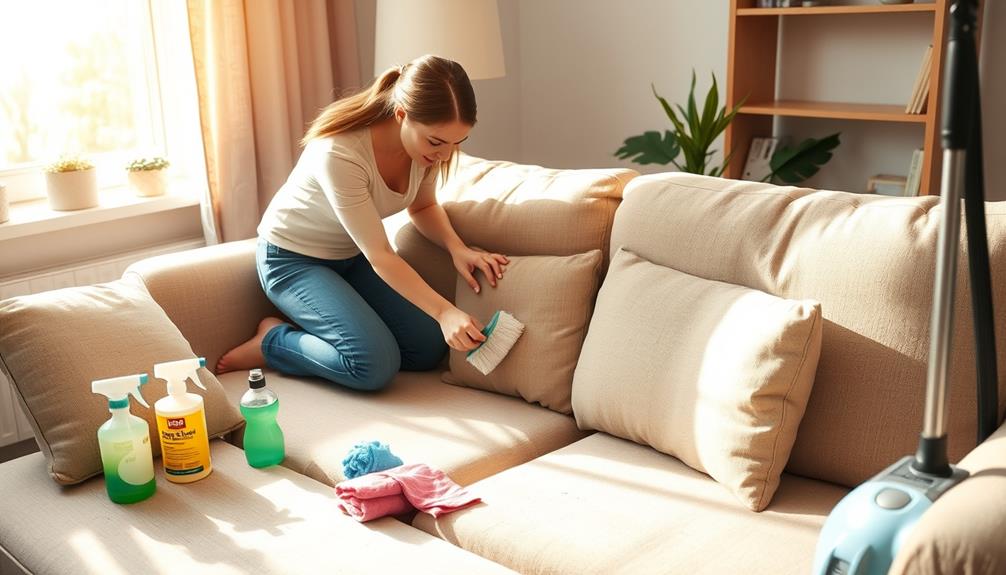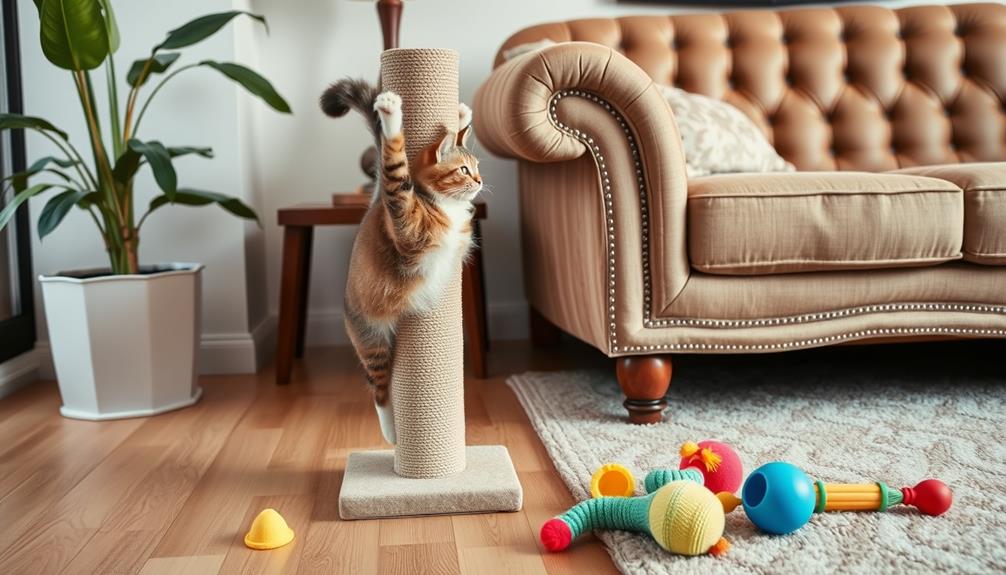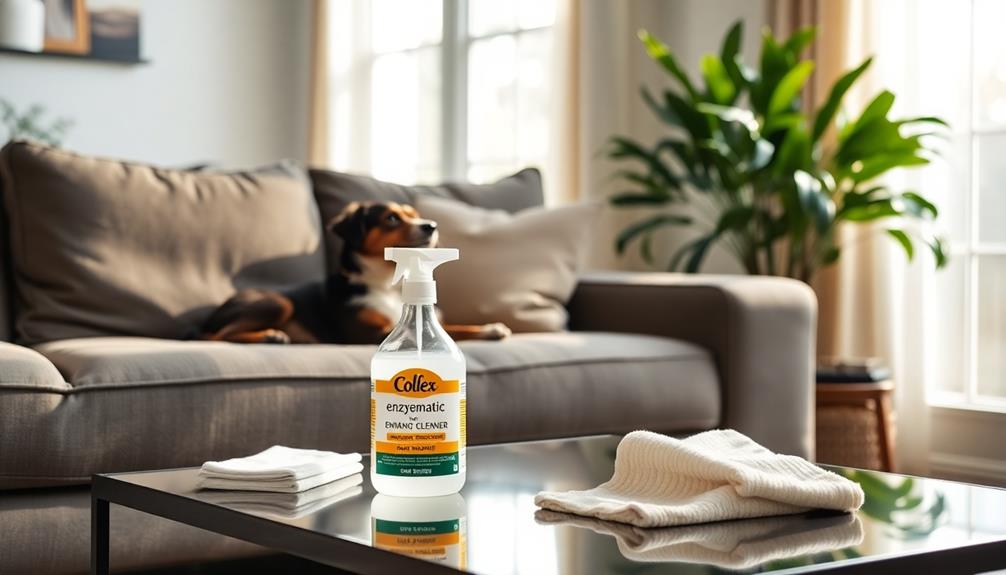To maintain your sofa’s cleanliness, begin by thoroughly vacuuming it every few weeks to eliminate dust and crumbs. Refer to the care tag to determine the fabric type, aiding in selecting the appropriate cleaning method. For spills, act quickly and blot with a clean cloth. Utilize a gentle detergent mixed with water or a specialized cleaner suitable for your sofa’s material. Consider steam cleaning for tougher stains and allergens. Remember to occasionally sprinkle baking soda to eradicate odors. For those looking to optimize their cleaning efforts, there is further information available on specific tools and techniques. When it comes to fabric sofa cleaning tips, consider employing a soft-bristled brush or a microfiber cloth to delicately scrub the fabric and eliminate any entrenched dirt. Avoid the use of harsh chemicals or abrasive materials that could harm the fabric. Testing any cleaning solution on a small, inconspicuous area of the sofa before applying it to the entire surface is advisable. By adhering to these fabric sofa cleaning tips, you can preserve your sofa’s appearance and comfort for years to come.
Key Takeaways
- Regularly vacuum your sofa every 1 to 2 weeks to prevent dirt buildup and maintain cleanliness.
- Identify the fabric type and follow the care instructions on the cleaning tag before using any cleaning solutions.
- Immediately blot spills with an absorbent cloth to prevent stains; use fabric-appropriate cleaning solutions for spot cleaning.
- Deep clean your sofa at least once or twice a year using steam cleaning or a dedicated upholstery cleaner for best results.
- Consider professional cleaning annually to address tough stains and extend the lifespan of your sofa.
Cleaning Frequency and Importance
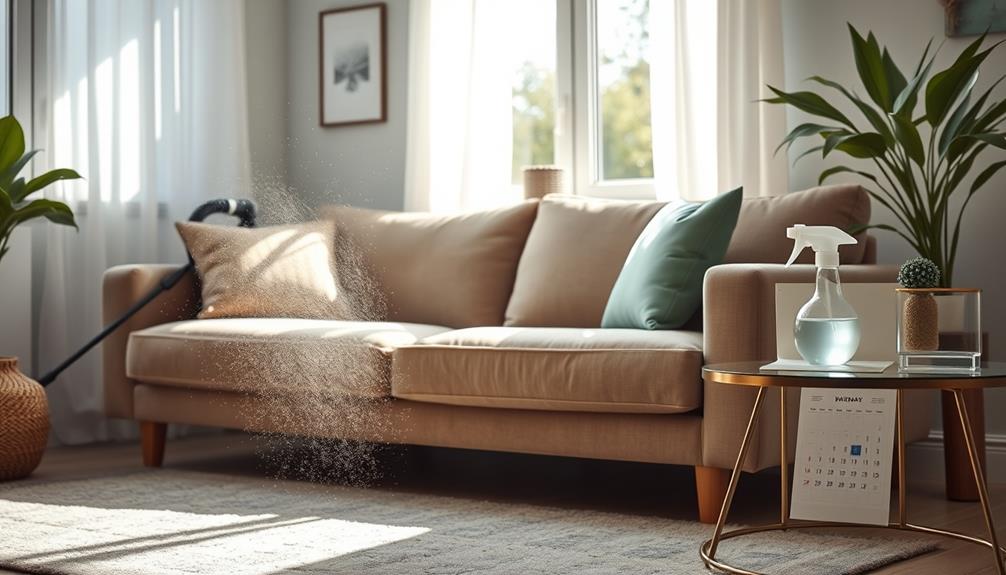
Cleaning your sofa regularly is essential for maintaining both its appearance and hygiene. Ideally, you should aim for regular cleaning every 12 to 18 months. If you have pets or use your furniture heavily, consider increasing that frequency.
Immediate cleaning of spills is imperative; tackling stains right away prevents them from setting in and causing lasting damage to your upholstery. Additionally, just as with carpets, using the right cleaning methods can greatly enhance the results and prolong the life of your sofa. For more information on effective cleaning techniques, check out different carpet cleaning methods.
In addition to routine maintenance, deep cleaning is recommended at least once or twice a year. This process not only helps eliminate dust and allergens but also improves indoor air quality, making your living space healthier.
Incorporating vacuuming into your routine maintenance every 3-4 weeks is essential for preventing dirt buildup, which can wear down your sofa over time.
Seasonal cleaning can also be beneficial, especially during allergy seasons or periods of heavy use. By establishing a cleaning frequency that fits your lifestyle, you can guarantee that your sofa remains in good condition.
Following these practices will help you maintain its appearance and prolong its lifespan, making your investment worthwhile.
Essential Cleaning Tools

To keep your sofa looking fresh, you need the right cleaning tools. Start with must-have supplies like a vacuum for effective cleaning, and don't forget to choose the right solutions for any stains.
Regular maintenance of your cleaning tools, such as air purifier maintenance dos and don'ts, can greatly enhance their performance. Knowing how to use these tools effectively can make a big difference in maintaining your sofa's appearance.
Must-Have Cleaning Supplies
When it comes to keeping your sofa in top shape, having the right cleaning supplies on hand is crucial.
Start with a Dyson Vacuum, which effectively removes dust and crumbs from fabric upholstery, guaranteeing regular maintenance is a breeze. For those stubborn stains, a Bissell Little Green Machine serves as a portable upholstery cleaner that tackles deep-set dirt and keeps your sofa looking fresh.
To enhance your cleaning routine, consider investing in one of the best vacuums for dust removal to guarantee your home stays free from allergens.
You'll also want a lint roller handy for quick touch-ups, zapping away hair and dust that can accumulate over time.
To maintain the aesthetic of your fabric upholstery, a fabric shaver can help remove pilling and fuzz, giving your sofa a clean, polished look.
Effective Vacuuming Techniques
While you're keeping your sofa in pristine condition, effective vacuuming techniques play an essential role in maintaining its appearance and longevity. Start by using a handheld vacuum or a vacuum with an upholstery attachment. This helps you effectively remove dust, crumbs, and pet hair from the sofa's surface and crevices.
To further enhance your cleaning routine, consider the benefits of appliance maintenance plans, which can extend the lifespan of your cleaning equipment. Don't forget to regularly vacuum both sides of removable cushions; this guarantees hidden debris is eliminated and maintains overall cleanliness.
For quick touch-ups between deeper cleanings, incorporate a lint brush. It's perfect for removing pet hair and small particles that a vacuum might miss. Fluffing and rotating cushions during vacuuming not only helps maintain their shape and comfort but also allows you to access areas that may collect dust.
Make vacuuming a part of your routine maintenance schedule, ideally every 3-4 weeks. This prevents dirt buildup and prolongs the lifespan of your upholstery.
Choosing Cleaning Solutions
Choosing the right cleaning solutions for your sofa is crucial for maintaining its appearance and durability. Different fabrics require specific products, so always check the care label before proceeding. For example, water-based cleaners work well on 'W' fabrics, while solvent-based cleaners are suitable for 'S' fabrics. Additionally, using natural essential oils for cleaning can help freshen up your upholstery while providing antimicrobial benefits.
Here are some essential cleaning tools to take into account:
- Handheld vacuum for debris removal
- Lint roller for quick hair and dust pickup
- Specialized upholstery cleaners tailored to your sofa's fabric
- DIY cleaning solutions made from common kitchen ingredients
If you're dealing with deep stains, a portable upholstery cleaner like the Bissell Little Green Machine is effective. For a more thorough clean, a steam cleaner can eliminate allergens while sanitizing fabric surfaces.
Don't forget to perform a spot test on a hidden area before using any new cleaning solution to verify it won't damage your sofa. Additionally, applying a Scotchgard protective spray can create a barrier against spills and stains, enhancing your sofa's longevity.
Identifying Fabric Types

To guarantee your sofa gets the proper care it needs, it's vital to identify the fabric type before you start cleaning. Check the care tag to find the cleaning code, which will guide your cleaning methods. Common upholstery fabrics include cotton, linen, polyester, leather, and microfiber, each requiring specific approaches to avoid damage.
Here's a quick reference to fabric types and their cleaning codes:
| Fabric Type | Cleaning Code |
|---|---|
| Cotton | W |
| Leather | S |
| Polyester | WS |
| Microfiber | W |
| Delicate Fabrics | X |
For water-safe fabrics (W), you can safely use a mixture of mild detergent and water. Solvent-only fabrics (S) should only be treated with dry-cleaning solutions. If your sofa has a cleaning code marked with X, remember that vacuuming is the only method allowed to prevent potential damage.
Understanding the fabric type is essential for selecting the appropriate cleaning solutions, ensuring your sofa remains in great shape for years to come.
Vacuuming Techniques
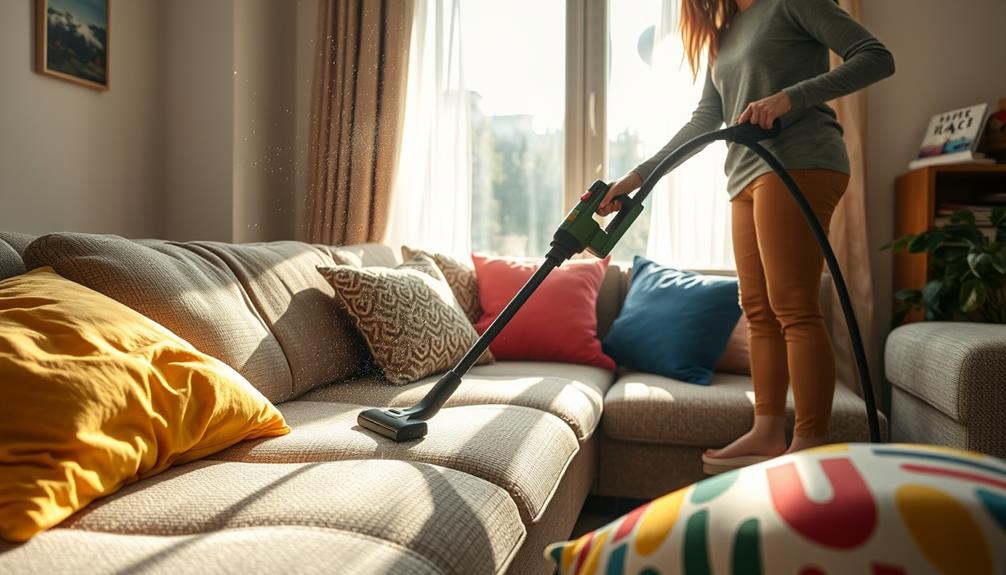
Regular vacuuming is essential for maintaining your sofa's cleanliness and longevity. Aim to vacuum your upholstery every 1 to 2 weeks to prevent dirt buildup and extend its life.
Use a vacuum cleaner with an upholstery attachment to effectively remove dust, crumbs, and pet hair from the fabric surfaces. Additionally, keeping your sofa clean can reduce allergens and enhance your overall indoor air quality, which is particularly important for those with sensitivities or respiratory issues.
Consider integrating cold medications overview into your cleaning routine to guarantee a healthier living environment.
Here are some tips for effective vacuuming techniques:
- Focus on Crevices: Use a crevice tool to get into those tight spaces where debris often hides.
- Remove Loose Cushions: Take the cushions off and vacuum both sides, plus the area beneath them, to eliminate hidden dirt and allergens.
- Quick Cleanups: Incorporate a lint brush or handheld vacuum for quick cleanups of small debris between regular sessions.
- Check Seams: Pay special attention to seams, as these areas can trap dust and pet hair.
Spot Cleaning Guidelines
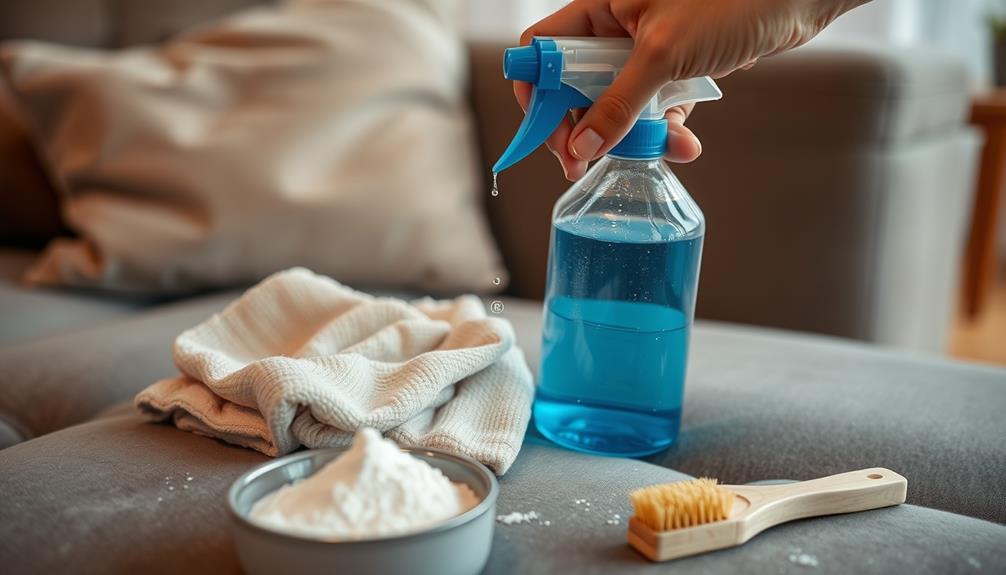
Spills can happen at any moment, making it vital to know how to spot clean your sofa effectively. First, act quickly! Blot spills immediately with an absorbent cloth using a gentle dabbing motion. Avoid rubbing, as this can push stains deeper into the fabric.
For fabric upholstery, create a cleaning solution by mixing equal parts of vinegar, water, and a few drops of mild dish soap. Additionally, maintaining a budget for home care can help set aside funds for cleaning supplies and professional help when necessary, guaranteeing your furniture remains in top condition a budget plan.
Before applying this mixture to the stain, always test with the solution on a hidden area of the fabric. This guarantees you won't cause any discoloration or damage. Once you're sure it's safe, apply the solution to the stained area and use a soft brush or cloth to gently scrub it.
Let the cleaning solution sit for a few minutes, then blot it dry with a clean cloth to remove excess moisture. After spot cleaning, allow the upholstery to air dry completely. This step is vital to prevent mildew and lingering odors.
Deep Cleaning Methods
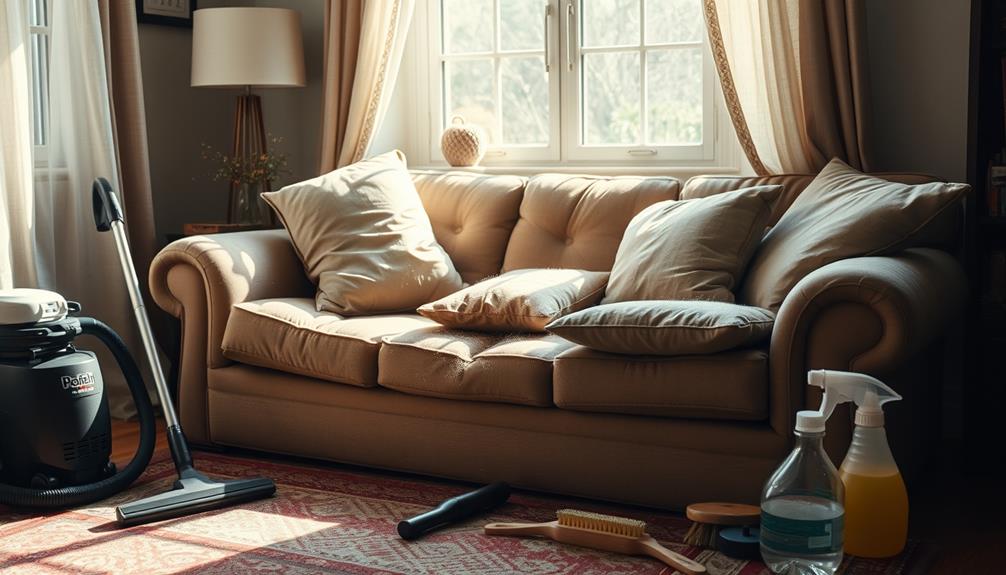
When it comes to deep cleaning your sofa, steam cleaning is one of the best techniques to eliminate stubborn stains and allergens.
Additionally, using a proper paint sprayer tip for cleaning solutions can enhance the effectiveness of your cleaning process.
You'll also want to keep some spot cleaning tips in mind for any quick touch-ups.
Plus, using the right deep cleaning equipment can make a significant difference in maintaining your sofa's appearance and longevity.
Steam Cleaning Techniques
If you want to revitalize your sofa and keep it looking fresh, steam cleaning is a highly effective method. This deep clean technique uses high-temperature steam to penetrate the fabric fibers, lifting dirt, allergens, and embedded stains without harsh chemicals.
Proper maintenance, including regular cleaning, can greatly enhance the longevity of your furniture routine health checks for signs of illness. To get started, follow these essential steps:
- Use a handheld steamer or a steam cleaner designed for upholstered furniture.
- Always perform a spot test on a hidden area to check for colorfastness.
- Confirm you follow the manufacturer's instructions regarding temperature and water levels.
- Allow the upholstery to dry thoroughly after steam cleaning to prevent mildew.
Regular steam cleaning, ideally every 12 to 18 months, can improve your sofa's appearance and prolong its lifespan.
By efficiently removing deep-seated dirt and allergens, you maintain not only the look of your sofa but also a healthier living environment.
Spot Cleaning Tips
Spot cleaning is essential for maintaining your sofa's appearance and preventing stains from becoming permanent. When a spill occurs, immediately blot the stain with an absorbent cloth, using a gentle dabbing motion instead of rubbing, which can spread the stain. For fabric upholstery, create a cleaning solution with vinegar, clean water, and dish soap. Apply this mixture using a clean sponge, and rinse with plain water to remove any residue.
Here's a quick reference table for effective spot cleaning:
| Stain Type | Cleaning Method | Additional Tip |
|---|---|---|
| Food/Beverage | Blot, then apply vinegar solution | Test any cleaning solution first |
| Ink | Use rubbing alcohol on a clean cloth | Blot gently, don't scrub |
| Grease | Apply dish soap solution, rinse with water | Repeat if necessary |
| Removable Covers | Machine wash according to care tag | verify they're thoroughly dried |
For microfiber couches, apply rubbing alcohol gently and let it dry before fluffing with a dry brush. Always test any cleaning solution on a hidden area first to avoid damage.
Deep Cleaning Equipment
While spot cleaning helps address immediate messes, deep cleaning your sofa is important for a thorough refresh. To achieve effective deep cleans, you'll need the right equipment.
Investing in a dedicated upholstery cleaning machine can make a significant difference. These machines use water and cleaning solutions to penetrate deep into the fabric fibers, lifting out dirt and stains effectively. Additionally, using energy-efficient cleaning solutions can contribute to a more sustainable home environment, just like optimal comfort in varying weather conditions provided by advanced heat pump systems.
Here are some recommended deep cleaning equipment options:
- Bissell Little Green Machine: A portable upholstery cleaner that tackles tough stains with powerful suction and specialized attachments.
- Steam Cleaner: This method uses high-temperature steam to eliminate dust mites and bacteria, ideal for homes with allergies or pets.
- Upholstery Cleaning Solution: Always choose a solution suitable for your fabric type for the best results.
- Soft Brush: Use a soft brush to agitate stains before deep cleaning for better penetration.
Before using any cleaning method, remember to perform a spot test to verify the solution won't damage your fabric.
Regular deep cleaning not only enhances your sofa's appearance but also improves indoor air quality by removing accumulated allergens.
Odor Removal Tips
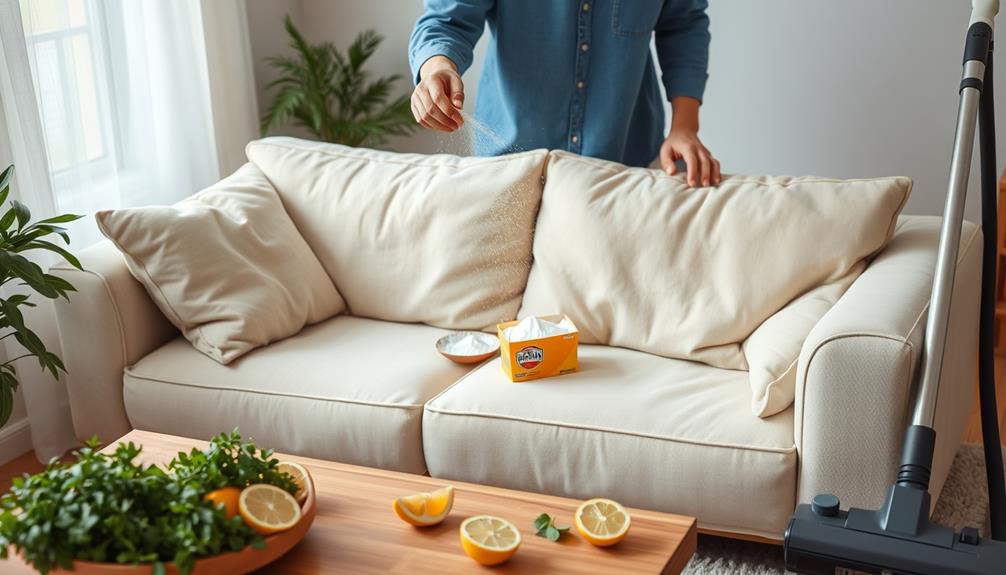
Dealing with unpleasant odors in your sofa can be frustrating, but effective solutions are within reach. Start by sprinkling baking soda on the affected area of your couch. Let it sit for at least 15 minutes to absorb odors, then vacuum it up. This simple method can greatly neutralize smells.
If you're targeting specific odors, opt for a fabric spray like Febreze FABRIC. Just spray it on the fabric and allow it to dry; your couch will feel fresher in no time.
For more persistent odors, mix equal parts vinegar and water in a spray bottle. Lightly mist this solution on the fabric and let it air dry to help eliminate strong smells.
To keep your couch smelling great, regularly freshen it as soon as you detect any odors, especially in homes with pets or heavy use.
Professional Cleaning Benefits

After tackling odors, it's important to contemplate the benefits of professional cleaning for your sofa. Hiring experts can greatly enhance your living space in multiple ways. Not only do they remove dust and allergens, but they also improve indoor air quality, creating a healthier environment for you and your family.
Here are some key benefits of opting for professional cleaning:
- Restore Appearance: Professionals utilize specialized equipment to tackle tough stains and restore your sofa's original look.
- Extend Lifespan: Regular professional cleaning helps maintain fabric integrity, allowing your furniture to last longer.
- Prevent Long-Term Damage: By addressing dirt and odors promptly, you can avoid costly repairs or replacements down the line.
- Tailored Cleaning Options: Many services offer customized cleaning plans, saving you time and effort while ensuring your specific needs are met.
With trained specialists handling the cleaning process, you can enjoy peace of mind, knowing advanced techniques and products are being used to care for your sofa.
Investing in professional cleaning not only enhances your sofa's appearance but also contributes to a healthier and more inviting home.
Regular Maintenance Practices

Maintaining your sofa regularly is essential for preserving its appearance and longevity. Start with regular vacuuming every 3-4 weeks to eliminate dust, crumbs, and pet hair. This simple practice prevents dirt buildup and extends the life of your fabric.
If your sofa has removable cushion covers, make sure to wash or dry clean them according to the care instructions. This keeps the fabric fresh and clean. If your sofa does not have removable cushion covers, you can still keep it clean by using a fabric cleaner or upholstery shampoo. It’s important to vacuum your sofa regularly to remove any dirt and debris. Another option for keeping your sofa clean and fresh is to use a slipcover that can be removed and washed. Attaching arms to armless sofa can be a simple and effective way to change up the look of your living room. This can also provide additional comfort and support for lounging. There are many tutorials and guides available online to help you with this process.
For added protection, consider applying a protective spray like Scotchgard after cleaning. This creates a barrier against spills, especially for absorbent fabrics like cotton and linen.
If an accident occurs, give immediate attention to spills and stains; it's vital to blot them with an absorbent cloth right away. Use appropriate cleaning solutions based on the fabric type to prevent long-term staining and damage.
Fluffing and Cushion Care

Cushion care is essential for keeping your sofa looking its best and feeling comfortable. One of the simplest ways to maintain your cushions is by fluffing them regularly. This helps restore their shape and prevents a lumpy appearance, enhancing the aesthetics of your sofa.
Additionally, rotating cushions every few weeks distributes wear evenly, extending their lifespan and improving overall comfort.
Here are some key tips for effective cushion care:
- Fluff down-filled cushions by gently kneading and shaking them to maintain their loft.
- Rotate cushions to guarantee even wear and prolong their usability.
- Vacuum removable cushion covers periodically to remove hidden debris and pet hair.
- Shake out cushion covers to keep them fresh and clean.
Frequently Asked Questions
What Is the Best Way to Clean a Fabric Sofa?
You've got a fabric sofa that's seen better days—like a battle-worn warrior! Start by checking the care tag, then vacuum regularly, spot clean spills, and consider steam cleaning to keep it looking fabulous.
How Do You Deep Clean a Dirty Couch?
To deep clean a dirty couch, start by vacuuming thoroughly. Then, mix vinegar, water, and dish soap, test it, and apply. Use a steamer or upholstery cleaner, blot stains, and let it air-dry completely.
Can I Clean My Couch With Dawn and Water?
Think of your couch as a canvas; you can absolutely clean it with Dawn and water. Just mix, spot test, and scrub gently. Remember, a light touch keeps your masterpiece looking fresh and vibrant!
How Do You Clean and Deodorize a Couch?
To clean and deodorize your couch, vacuum thoroughly, sprinkle baking soda, and let it sit. Mix vinegar and water for stains, blot with a cloth, and use fabric-safe disinfectants to finish the job effectively.
Conclusion
Now that you know how to tackle your sofa cleaning, envision this: you're sinking into a fresh, spotless couch, the fabric inviting and vibrant. You can almost smell the crisp scent of cleanliness in the air. But wait—what if you miss that stubborn stain hiding in the corner? Or the lingering odor trapped in the cushions? Don't let those worries linger; take action today and transform your sofa into the cozy haven it's meant to be!
